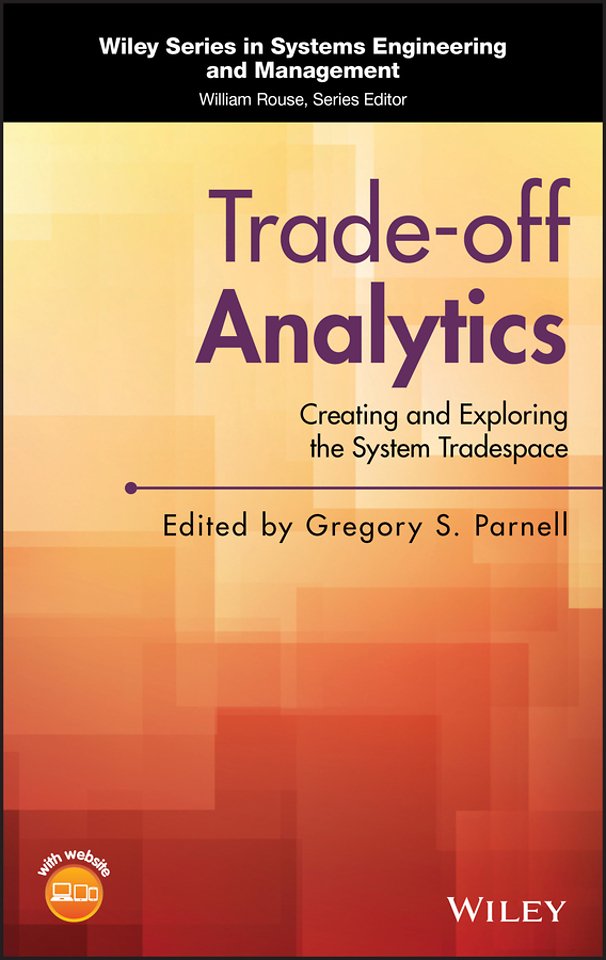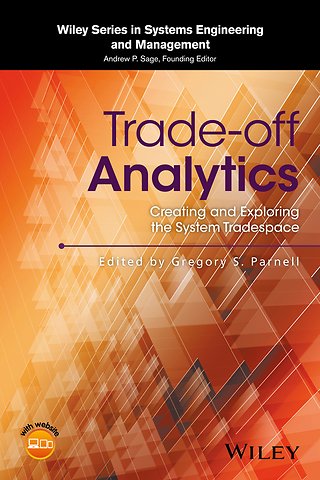Trade–off Analytics – Creating and Exploring the System Tradespace
Creating and Exploring the System Tradespace
Gebonden Engels 2017 9781119237532Samenvatting
Presents information to create a trade–off analysis framework for use in government and commercial acquisition environments
This book presents a decision management process based on decision theory and cost analysis best practices aligned with the ISO/IEC 15288, the Systems Engineering Handbook, and the Systems Engineering Body of Knowledge. It provides a sound trade–off analysis framework to generate the tradespace and evaluate value and risk to support system decision–making throughout the life cycle. Trade–off analysis and risk analysis techniques are examined. The authors present an integrated value trade–off and risk analysis framework based on decision theory. These trade–off analysis concepts are illustrated in the different life cycle stages using multiple examples from defense and commercial domains.
Provides techniques to identify and structure stakeholder objectives and creative, doable alternatives
Presents the advantages and disadvantages of tradespace creation and exploration techniques for trade–off analysis of concepts, architectures, design, operations, and retirement
Covers the sources of uncertainty in the system life cycle and examines how to identify, assess, and model uncertainty using probability
Illustrates how to perform a trade–off analysis using the INCOSE Decision Management Process using both deterministic and probabilistic techniques
Trade–off Analytics: Creating and Exploring the System Tradespace is written for upper undergraduate students and graduate students studying systems design, systems engineering, industrial engineering and engineering management. This book also serves as a resource for practicing systems designers, systems engineers, project managers, and engineering managers.
Gregory S. Parnell, PhD, is a Research Professor in the Department of Industrial Engineering at the University of Arkansas. He is also a senior principal with Innovative Decisions, Inc., a decision and risk analysis firm and has served as Chairman of the Board. Dr. Parnell has published more than 100 papers and book chapters and was lead editor of Decision Making for Systems Engineering and Management, Wiley Series in Systems Engineering (2nd Ed, Wiley 2011) and lead author of the Handbook of Decision Analysis (Wiley 2013). He is a fellow of INFORMS, the INCOSE, MORS, and the Society for Decision Professionals.
Specificaties
Lezersrecensies
Inhoudsopgave
<p>About the Authors xxi</p>
<p>Foreword xxxi</p>
<p>Preface xxxiii</p>
<p>Acknowledgments xli</p>
<p>About the Companion Website xlv</p>
<p>1 Introduction to Trade–off Analysis 1<br />Gregory S. Parnell Matthew Cilli Azad M. Madni and Garry Roedler</p>
<p>1.1 Introduction 2</p>
<p>1.2 Trade–off Analyses Throughout the Life Cycle 3</p>
<p>1.3 Trade–off Analysis to Identify System Value 3</p>
<p>1.4 Trade–off Analysis to Identify System Uncertainties and Risks 6</p>
<p>1.5 Trade–off Analyses can Integrate Value and Risk Analysis 6</p>
<p>1.6 Trade–off Analysis in the Systems Engineering Decision Management Process 8</p>
<p>1.7 Trade–off Analysis Mistakes of Omission and Commission 9</p>
<p>1.8 Overview of the Book 20</p>
<p>1.9 Key Terms 24</p>
<p>1.10 Exercises 25</p>
<p>References 26</p>
<p>2 A Conceptual Framework and Mathematical Foundation for Trade–Off Analysis 29<br />Gregory S. Parnell Azad M. Madni and Robert F. Bordley</p>
<p>2.1 Introduction 29</p>
<p>2.2 Trade–Off Analysis Terms 30</p>
<p>2.3 Influence Diagram of the Tradespace 31</p>
<p>2.4 Tradespace Exploration 46</p>
<p>2.5 Summary 46</p>
<p>2.6 Key Words 47</p>
<p>2.7 Exercises 48</p>
<p>References 48</p>
<p>3 Quantifying Uncertainty 51<br />Robert F. Bordley</p>
<p>3.1 Sources of Uncertainty in Systems Engineering 51</p>
<p>3.2 The Rules of Probability and Human Intuition 52</p>
<p>3.3 Probability Distributions 56</p>
<p>3.4 Estimating Probabilities 66</p>
<p>3.5 Modeling Using Probability 72</p>
<p>3.6 Summary 81</p>
<p>3.7 Key Terms 81</p>
<p>3.8 Exercises 83</p>
<p>References 86</p>
<p>4 ANALYZING RESOURCES 91<br />Edward A. Pohl Simon R. Goerger and Kirk Michealson</p>
<p>4.1 Introduction 91</p>
<p>4.2 Resources 92</p>
<p>4.3 Cost Analysis 99</p>
<p>4.4 Affordability Analysis 135</p>
<p>4.5 Key Terms 147</p>
<p>4.6 Excercises 149</p>
<p>References 152</p>
<p>5 Understanding Decision Management 155<br />Matthew Cilli and Gregory S. Parnell</p>
<p>5.1 Introduction 155</p>
<p>5.2 Decision Process Context 156</p>
<p>5.3 Decision Process Activities 157</p>
<p>5.4 Summary 199</p>
<p>5.5 Key Terms 199</p>
<p>5.6 Exercises 200</p>
<p>References 201</p>
<p>6 Identifying Opportunities 203<br />Donna H. Rhodes and Simon R. Goerger</p>
<p>6.1 Introduction 203</p>
<p>6.2 Knowledge 205</p>
<p>6.3 Decision Traps 207</p>
<p>6.4 Techniques 210</p>
<p>6.5 Tools 219</p>
<p>6.6 Illustrative Examples 223</p>
<p>6.7 Key Terms 228</p>
<p>6.8 Exercises 230</p>
<p>References 230</p>
<p>7 Identifying Objectives and Value Measures 233<br />Gregory S. Parnell and William D. Miller</p>
<p>7.1 Introduction 233</p>
<p>7.2 Value–Focused Thinking 234</p>
<p>7.3 Shareholder and Stakeholder Value 236</p>
<p>7.4 Challenges in Identifying Objectives 238</p>
<p>7.5 Identifying the Decision Objectives 239</p>
<p>7.6 The Financial or Cost Objective 241</p>
<p>7.7 Developing Value Measures 243</p>
<p>7.8 Structuring Multiple Objectives 243</p>
<p>7.9 Illustrative Examples 248</p>
<p>7.10 Summary 250</p>
<p>7.11 Key Terms 252</p>
<p>7.12 Exercises 253</p>
<p>References 255</p>
<p>8 DEVELOPING AND EVALUATING ALTERNATIVES 257<br />C. Robert Kenley Clifford Whitcomb and Gregory S. Parnell</p>
<p>8.1 Introduction 257</p>
<p>8.2 Overview of Decision–making Creativity and Teams 258</p>
<p>8.3 Alternative Development Techniques 263</p>
<p>8.4 Assessment of Alternative Development Techniques 275</p>
<p>8.5 Alternative Evaluation Techniques 276</p>
<p>8.6 Assessment of Alternative Evaluation Techniques 290</p>
<p>8.7 Key Terms 290</p>
<p>8.8 Exercises 290</p>
<p>References 293</p>
<p>9 An Integrated Model for Trade–Off Analysis 297<br />Alexander D. MacCalman Gregory S. Parnell and Sam Savage</p>
<p>9.1 Introduction 297</p>
<p>9.2 Conceptual Design Example 298</p>
<p>9.3 Integrated Approach Influence Diagram 300</p>
<p>9.4 Other Types of Trade–Off Analysis 322</p>
<p>9.5 Simulation Tools 322</p>
<p>9.6 Summary 329</p>
<p>9.7 Key Terms 330</p>
<p>9.8 Exercises 331</p>
<p>References 335</p>
<p>10 EXPLORING CONCEPT TRADE–OFFS 337<br />Azad M. Madni and Adam M. Ross</p>
<p>10.1 Introduction 337</p>
<p>10.2 Defining the Concept Space and System Concept of Operations 345</p>
<p>10.3 Exploring the Concept Space 346</p>
<p>10.4 Trade–off Analysis Frameworks 348</p>
<p>10.5 Tradespace and System Design Life Cycle 349</p>
<p>10.6 From Point Trade–offs to Tradespace Exploration 351</p>
<p>10.7 Value–based Multiattribute Tradespace Analysis 351</p>
<p>10.8 Illustrative Example 359</p>
<p>10.9 Conclusions 369</p>
<p>10.10 Key Terms 371</p>
<p>10.11 Exercises 372</p>
<p>References 372</p>
<p>11 Architecture Evaluation Framework 377<br />James N. Martin</p>
<p>11.1 Introduction 377</p>
<p>11.2 Key Considerations in Evaluating Architectures 385</p>
<p>11.3 Architecture Evaluation Elements 389</p>
<p>11.4 Steps in an Architecture Evaluation Process 396</p>
<p>11.5 Example Evaluation Taxonomy 398</p>
<p>11.6 Summary 400</p>
<p>11.7 Key Terms 400</p>
<p>11.8 Exercises 402</p>
<p>References 402</p>
<p>12 Exploring the Design Space 405<br />Clifford Whitcomb and Paul Beery</p>
<p>12.1 Introduction 405</p>
<p>12.2 Example 1: Liftboat 406</p>
<p>12.3 Example 2: Cruise Ship Design 411</p>
<p>12.4 Example 3: NATO Naval Surface Combatant Ship 417</p>
<p>12.5 Key Terms 431</p>
<p>12.6 Exercises 433</p>
<p>References 435</p>
<p>13 SUSTAINMENT RELATED MODELS AND TRADE STUDIES 437<br />John E. MacCarthy and Andres Vargas</p>
<p>13.1 Introduction 437</p>
<p>13.2 Availability Modeling and Trade Studies 439</p>
<p>13.3 Sustainment Life Cycle Cost Modeling and Trade Studies14 454</p>
<p>13.4 Optimization in Availability Trade Studies 464</p>
<p>13.5 Monte Carlo Modeling 471</p>
<p>13.6 Chapter Summary 475</p>
<p>13.7 Key Terms 476</p>
<p>13.8 Exercises 478</p>
<p>References 482</p>
<p>14 Performing Programmatic Trade–Off Analyses 483<br />Gina Guillaume–Joseph and John E. MacCarthy</p>
<p>14.1 Introduction 483</p>
<p>14.2 System Acceptance Decisions and Trade Studies 485</p>
<p>14.3 Product Cancelation Decision Trade Study 512</p>
<p>14.4 Product Retirement Decision Trade Study 538</p>
<p>14.5 Key Terms 562</p>
<p>14.6 Exercises 564</p>
<p>References 566</p>
<p>15 SUMMARY AND FUTURE TRENDS 571<br />Gregory S. Parnell and Simon R. Goerger</p>
<p>15.1 Introduction 571</p>
<p>15.2 Major Trade–Off Analysis Themes 572</p>
<p>15.3 Future of Trade–Off Analysis 576</p>
<p>15.4 Summary 581</p>
<p>References 581</p>
<p>Index 583</p>
Rubrieken
- advisering
- algemeen management
- coaching en trainen
- communicatie en media
- economie
- financieel management
- inkoop en logistiek
- internet en social media
- it-management / ict
- juridisch
- leiderschap
- marketing
- mens en maatschappij
- non-profit
- ondernemen
- organisatiekunde
- personal finance
- personeelsmanagement
- persoonlijke effectiviteit
- projectmanagement
- psychologie
- reclame en verkoop
- strategisch management
- verandermanagement
- werk en loopbaan

